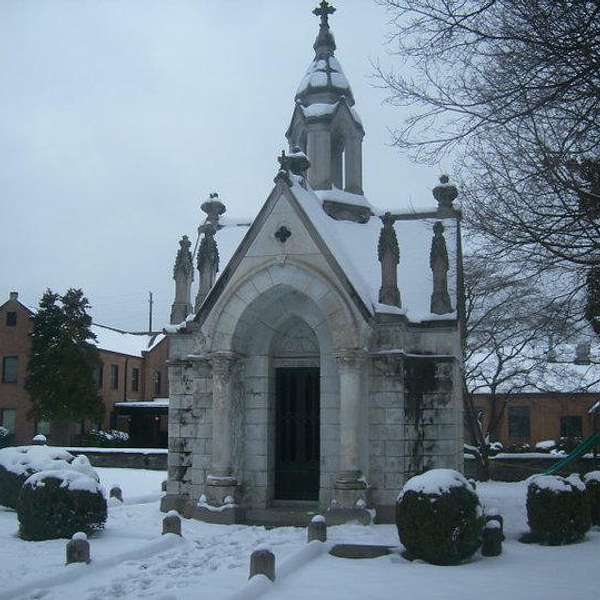
Tennessee Ghosts and Legends
Join me on a journey through Tennessee's mysterious and haunted past! Each season will be comprised of ten episodes you don't want to miss. You'll hear about some of the volunteer state's more famous and lesser known hauntings, and learn the local lore behind the legend. I am your host, Lyle Russell, and this is Tennessee Ghosts and Legends!
Tennessee Ghosts and Legends
Episode 11: The Bleeding Mausoleum
Cleveland, Tennessee is home to a strange legend of the tragedy of young Nina Craigmiles and the white mausoleum her father built for her. The legend says the white marble stones bleed red.
John Craigmiles was all too familiar with danger and risk. In his early years, he was a successful sea captain who owned and operated his own shipping business, running trade goods on the currents between the United States and South America. After encounters with pirates, trials and tribulations of the high seas, and a profitable land-based business venture selling supplies to both the North and South during the Civil War, nothing could rattle the nerves of the adventurous John Craigmiles. Nothing, that is, until the birth of his daughter.
The young Nina Craigmiles was born to John and his wife, Adelia on August 5th, 1864, in the town of Cleveland, Tennessee, just a few miles north of Chattanooga. Little Nina was an extraordinarily beautiful child, adored by not only her family but the entire town. As little Nina grew, she would often be seen about town with her maternal grandfather, Dr. Gideon Thompson. Any time the good doctor would leave in his horse-drawn buggy to make his rounds, Nina would accompany him, often urging her papa to make the horses go faster from visit to visit. Sometimes, he would even let her hold the reins.
On a fateful fall afternoon in October of 1871, on St. Luke’s Day, Doctor Thompson was summoned to do his rounds when a storm was coming. With bad weather rapidly approaching, he intended to go alone, but the now seven-year-old little Nina insisted on accompanying her papa like always for the ride. He did not want to take her out in the storm, but it was difficult to refuse his darling granddaughter. They loaded in the buggy and off they went into the rain. What happened next took a turn for the worst. It is unknown if the horses were spooked by something, possibly a lightning strike or thunderclap, that sent them in a sprint or if Gideon was driving them faster than usual to get out of the rain. In either case, the horses got running too fast to control. The buggy ended up heading for a railroad crossing through the middle of town when a train was coming. The horses simply would not stop and ran at nearly a full gallop toward the oncoming train. Sources differ on whether Gideon or Nina held the reins, but regardless of who was driving, the carriage was quickly run down by the thundering locomotive. Gideon was thrown clear and survived with minor injuries. Both horses and little Nina Craigmiles were killed on impact.
The entire town mourned the loss of “Princess Nina,” as many had come to call her. The funeral services were attended from far and wide. Family, friends, and strangers alike came offering condolences to the heartbroken family. John took the loss particularly hard but put his industrious-yet-troubled mind to work immediately on designing and building a spectacular cathedral in honor of his little girl. Being a man of considerable means, John was able to fully design and construct the church in a very short time. This feat was even more extraordinary since the project was completed so quickly despite the southern landscape being hampered by the oppressive effects of Reconstruction. Nevertheless, on the one-year anniversary of his daughter’s death, the St. Luke’s Memorial Episcopal Church was consecrated in 1872, becoming the meeting house of the St. Alban’s Church congregation that did not have a place to meet.
It is said on the day the church opened, John unlocked the front door and destroyed the only key to ensure anyone at any time could come into the church in remembrance of his beloved Nina. He incorporated an alcove in the church design, known as Nina’s niche, and directed that fresh flowers be placed there daily for her. The design of the church is very unique to the area, being one of the few Oxford Movement gothic architectural designs to remain wholly intact, with only slight modern additions of electricity, heating, and cooling. What’s even more unique than his cathedral design, however, is the next plan he created: a mausoleum that would house little Nina’s remains on the church grounds.
After the church was completed, John immediately set to work on his elaborate and costly design of a gothic, white marble mausoleum for Nina to be built right next to the church. The church building itself took only a year to design and construct, but John took more time and care with the final resting place of his daughter. The walls would be nearly four feet thick of the finest white Carrara marble, with carved spires featuring intricate angels and lambs reaching nearly forty feet high. After three years of work, the stately and very expensive structure was completed, and little Nina’s remains were interred in a white marble sarcophagus adorned with a carving of her covered body lying in state, complete with a marble crown and cross. All told, the church cost about $25,000, and the smaller mausoleum around $20,000 to build. Together and in today’s dollars, the family spent the equivalent of $1.1 million on the project.
John’s mind was fixed on honoring his daughter’s memory with the pure white marble structure, but something very strange happened after it was built: the white stones in the entry arch above the door began to bleed.
Shortly after Nina’s remains were interred, the white marble above the entry archway turned a deep red. Carrara marble is known for its bright white crystal structure with bluish-grey veins. Never has there been Carrara marble that turned red. It is said that John was furious that the incredibly expensive marble did not stay white and paid to have the archway rebuilt with new marble at least three times, yet each time and without explanation, the marble would begin to turn red. At different times after, the family hired workmen and masons to clean the streaks, but to no avail. The marble stayed red.
Carrara marble comes from the town of Carrara, Italy and is known world-wide for its luxurious appearance and durability. It is possible to stain it if a substance is left on it without cleaning, like red wine for example, but in the case of the mausoleum archway, the stains are on the underside of the marble, so an external substance causing the stains is unlikely. As with any natural stone harvested in a quarry, there is always the possibility of another element contaminating the marble naturally, such as an iron deposit, which would appear rust-colored or red when exposed to moisture and oxygen. In one investigation I read concerning the marble, a chemical test of a chip from the stone was performed, and no trace of iron was found in the crystal formation, a finding that only deepened the mystery. There was simply no natural explanation for the red streaks in the stone. This led many to believe the only possible explanation was supernatural: that the stones bled to signify the tragic end of young Nina, and that the red hue deepened with the addition of each member of the Craigmiles family to the crypt. In his will, John Craigmiles dictated exactly what was to be done with his remains: “I wish to very plainly be buried in the lower-hand catacomb in the vault or mausoleum where sleeps the ashes of our darling little Nina.” A few years later, his last wish would be granted.
In the winter of 1898, John Craigmiles was walking through town after a snowstorm and took a bad fall on ice across the road. While records are inconclusive to the extent of the injuries he suffered from the fall, treatments he received due to it caused a severe bout of blood poisoning. He passed away in January of 1899 at the age of 73. His wife, Adelia, would remarry and survive into her 80s, only to be hit by a car on an adjacent road where John fell almost 30 years earlier. Adelia would pass away in 1928 from the accident at 86 years old. Both parent’s remains were added to the crypt, and the rumors of the bleeding stones say the red streaks became darker with each family member’s internment.
As with any good mystery, embellishments are bound to occur, and this tale is no different. In one popular version, it is said that during the design phase of St. Luke’s Episcopal Church, John Craigmiles corresponded with a highly-skilled Italian sculptor. After a lengthy negotiation, a bargain was struck to carve a statue of Nina to adorn the church grounds. Once the statue was carved, the sculptor delayed shipping the piece to America for installation. For what reason, no one knows. When he finally did crate the statue for shipping, it was loaded at the Southampton Docks aboard the HMS Titanic. As everyone knows, the ship never arrived in America and Nina’s statue now rests at the bottom of the Atlantic Ocean.
This is an unlikely possibility that does not seem plausible simply due to the timeline. Nina was killed in 1871, the church was consecrated in 1872, the mausoleum finished in 1876, John Craigmiles passed away in 1899, and the HMS Titanic sank in 1912; some 39 years after the church was built and 13 years after John died. While it’s possible he investigated commissioning a statue, it would not have sailed aboard the Titanic and no record or receipt for a commission has been found.
A final take on this story is the reported sightings of a young girl in 19th century period dress walking through the cemetery, as well as a specter thought to be John Craigmiles walking around the mausoleum, forever inspecting the marble structure he painstakingly built for his darling Nina. While reported ghost sightings in cemeteries is a common occurrence, these sightings are notoriously difficult to prove or document. After an extensive search, I was not able to find any reports of paranormal investigations of this site. With so many knowing the sad story of the bleeding mausoleum and the tragedies of young Nina and her family interred inside, an overactive imagination is the likely source of the sightings.
Even so, is it possible that Nina and her family still walk the grounds of St. Luke’s Episcopal Church? Paranormal experts say that sites of tragedy or great significance to those passed on will harbor the residuals of their memories and sometimes their spirits. The church and grounds were very important to John Craigmiles and their family after Nina’s death, and the spiritual connection to the buildings would be strong. And what of the red stains in the marble? Are they some natural blemish in the usually bright white marble, or are they the spiritual manifestation of the tragedy surrounding Nina’s untimely death?
Today, the grounds are open to the public and you can visit both the church and the mausoleum to see the stones for yourself. As this is an active church and cemetery, great care and respect should be taken when visiting to not disturb the grounds or the structures. Though I have never visited the mausoleum personally, I have added it to my list of Tennessee destinations to visit and pay my respects to Nina and her family, and to see the red marble for myself; one of east Tennessee’s most enduring unexplained mysteries.
Podcasts we love
Check out these other fine podcasts recommended by us, not an algorithm.

Southern Gothic
Southern Gothic Media